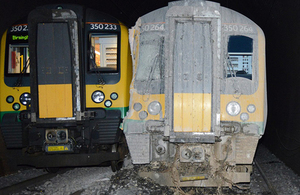Derailment and collision, Watford tunnel
Investigation into passenger train derailment and subsequent collision, Watford, Hertfordshire, 16 September 2016.

Trains involved in accident, derailed train on the right (image courtesy of BTP)
At about 06:55 hrs on Friday 16 September 2016, a southbound passenger train was travelling at about 70 mph (112 km/h) on the up slow line of the West Coast Main Line, when the leading carriage was derailed by a landslip just before entering the northern portal of Watford tunnel. The train stopped in the tunnel, partly blocking the adjacent line. About two minutes later, it was struck a glancing blow by a northbound passenger train which did not derail. Two passengers suffered minor injuries. Both trains suffered significant damage, including the cab to saloon door on the derailed train becoming jammed.
The southbound train was the 06:19 hrs service from Milton Keynes to London Euston, comprising two four-coach class 350 electric multiple units; a total of eight coaches. The northbound service was the 06:34 hrs service from London Euston to Birmingham and was formed by one four-coach class 350 unit. The two trains were carrying more than 150 passengers who were transferred onto another train which took them from the tunnel at about 10:40 hrs.
The driver of the southbound train used an emergency facility on the train’s in-cab radio to alert other train drivers. The driver of the northbound train received the emergency stop message via his in-cab radio and applied the brake, slowing the train from 80 mph (129 km/h) to 32 mph (51 km/h) before the collision.
The landslip material which caused the derailment had slid from the steep-sided, deep cutting on the tunnel approach after very heavy rainfall in the two hours immediately before the accident. The preceding southbound train had passed the site without incident at 06:43 hrs. The sides of this cutting were being strengthened at the time of the accident, but this work had not yet reached the location where the landslip occurred.
Our investigation will identify the sequence of events that led to the accident.
It will also include consideration of:
- why the landslip occurred
- issues affecting the stability of the cutting slope
- knowledge of, and response to, the heavy rainfall
- the actions of staff and performance of safety systems between the derailment and subsequent collision
- any relevant underlying management factors.
Our investigation is independent of any investigation by the railway industry, the Office of Rail and Road, and the British Transport Police.
We will publish our findings, including any safety recommendations, at the conclusion of our investigation; these will be available on our RAIB website.
You can subscribe to automated emails notifying you when we publish our reports.